Strategic Report: Addressing Key Issues at Museum of Contemporary Arts
VerifiedAdded on 2023/06/04
|15
|3549
|418
Report
AI Summary
This report identifies and analyzes strategic issues encountered by the Museum of Contemporary Arts in Australia, focusing on challenges related to funding, the evolving role of the museum, lack of information on contemporary materials, inappropriate conservation treatments, ethical dilemmas, documentation, information sharing, and education/training. The analysis considers Porter’s generic strategy framework to evaluate these issues and provides recommendations for improvement. Key strategic issues include balancing the museum's traditional role with demands for popular culture, declining capital and grants, shrinking supply of art materials, pressure to provide entertaining programs, and a lack of knowledge regarding contemporary art materials. The report emphasizes the need for addressing ethical considerations, improving documentation methods, enhancing information sharing, and investing in education and training for conservators. The goal is to provide a broader understanding of strategic concepts and practices relevant to the Museum of Contemporary Arts.
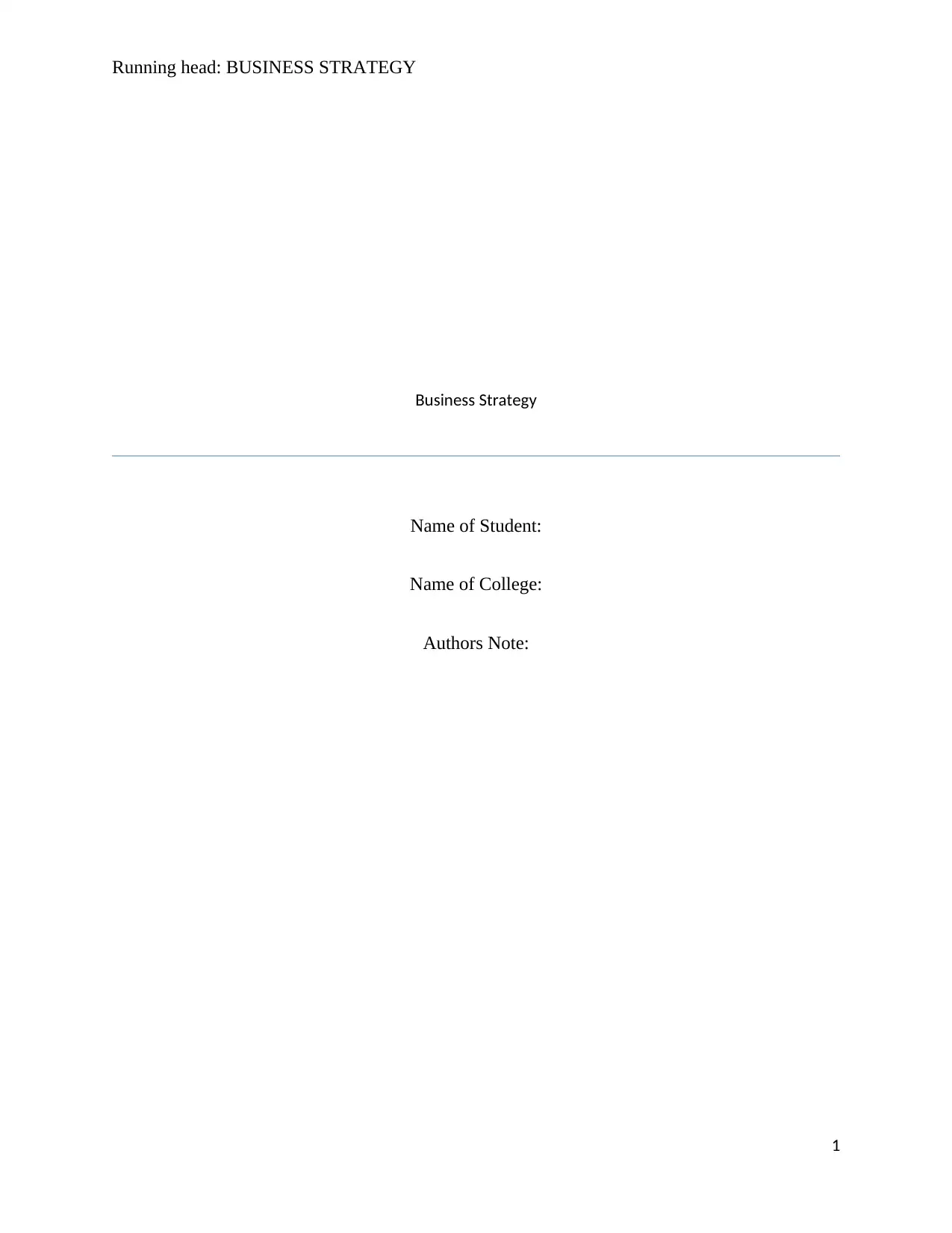
Running head: BUSINESS STRATEGY
Business Strategy
Name of Student:
Name of College:
Authors Note:
1
Business Strategy
Name of Student:
Name of College:
Authors Note:
1
Paraphrase This Document
Need a fresh take? Get an instant paraphrase of this document with our AI Paraphraser
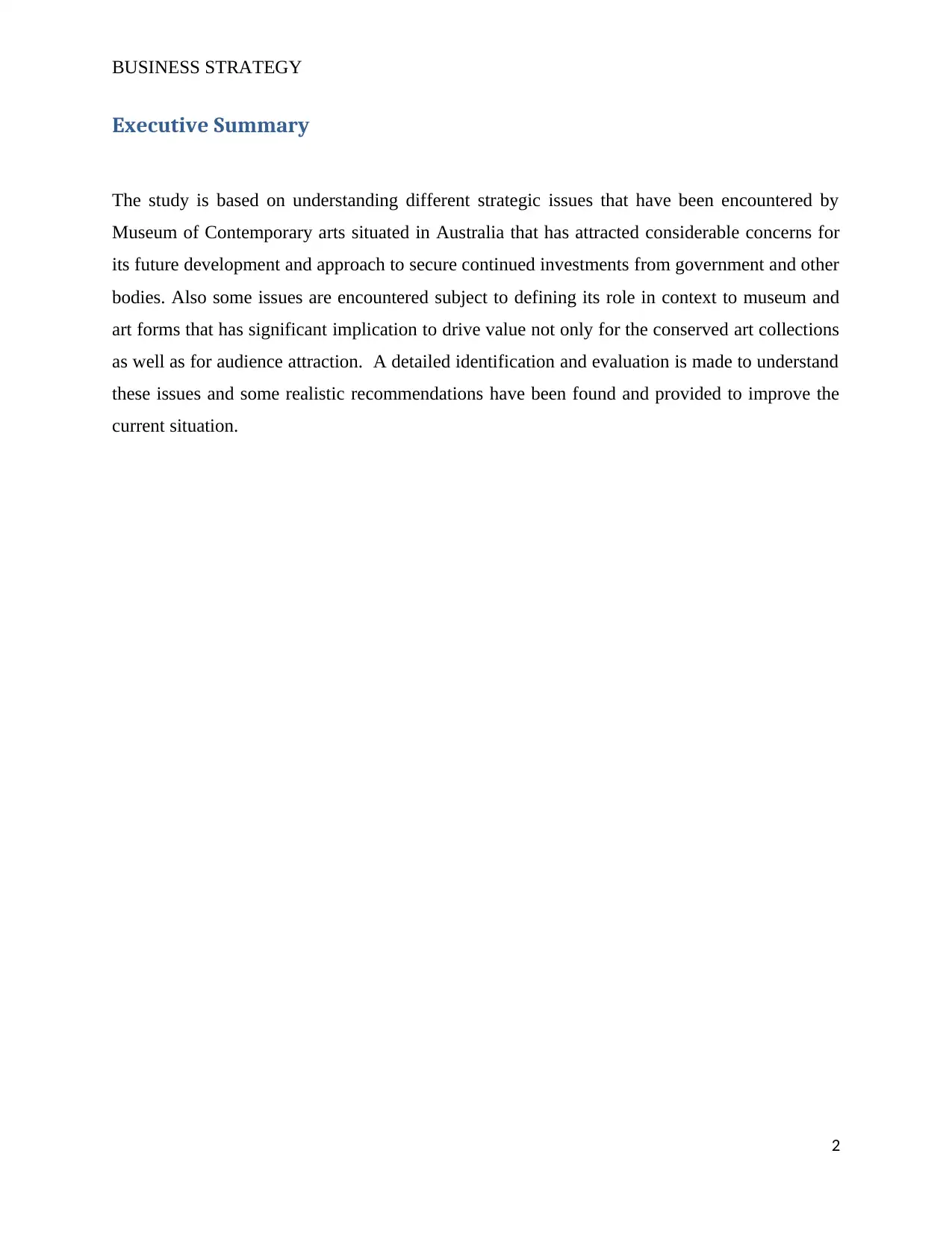
BUSINESS STRATEGY
Executive Summary
The study is based on understanding different strategic issues that have been encountered by
Museum of Contemporary arts situated in Australia that has attracted considerable concerns for
its future development and approach to secure continued investments from government and other
bodies. Also some issues are encountered subject to defining its role in context to museum and
art forms that has significant implication to drive value not only for the conserved art collections
as well as for audience attraction. A detailed identification and evaluation is made to understand
these issues and some realistic recommendations have been found and provided to improve the
current situation.
2
Executive Summary
The study is based on understanding different strategic issues that have been encountered by
Museum of Contemporary arts situated in Australia that has attracted considerable concerns for
its future development and approach to secure continued investments from government and other
bodies. Also some issues are encountered subject to defining its role in context to museum and
art forms that has significant implication to drive value not only for the conserved art collections
as well as for audience attraction. A detailed identification and evaluation is made to understand
these issues and some realistic recommendations have been found and provided to improve the
current situation.
2
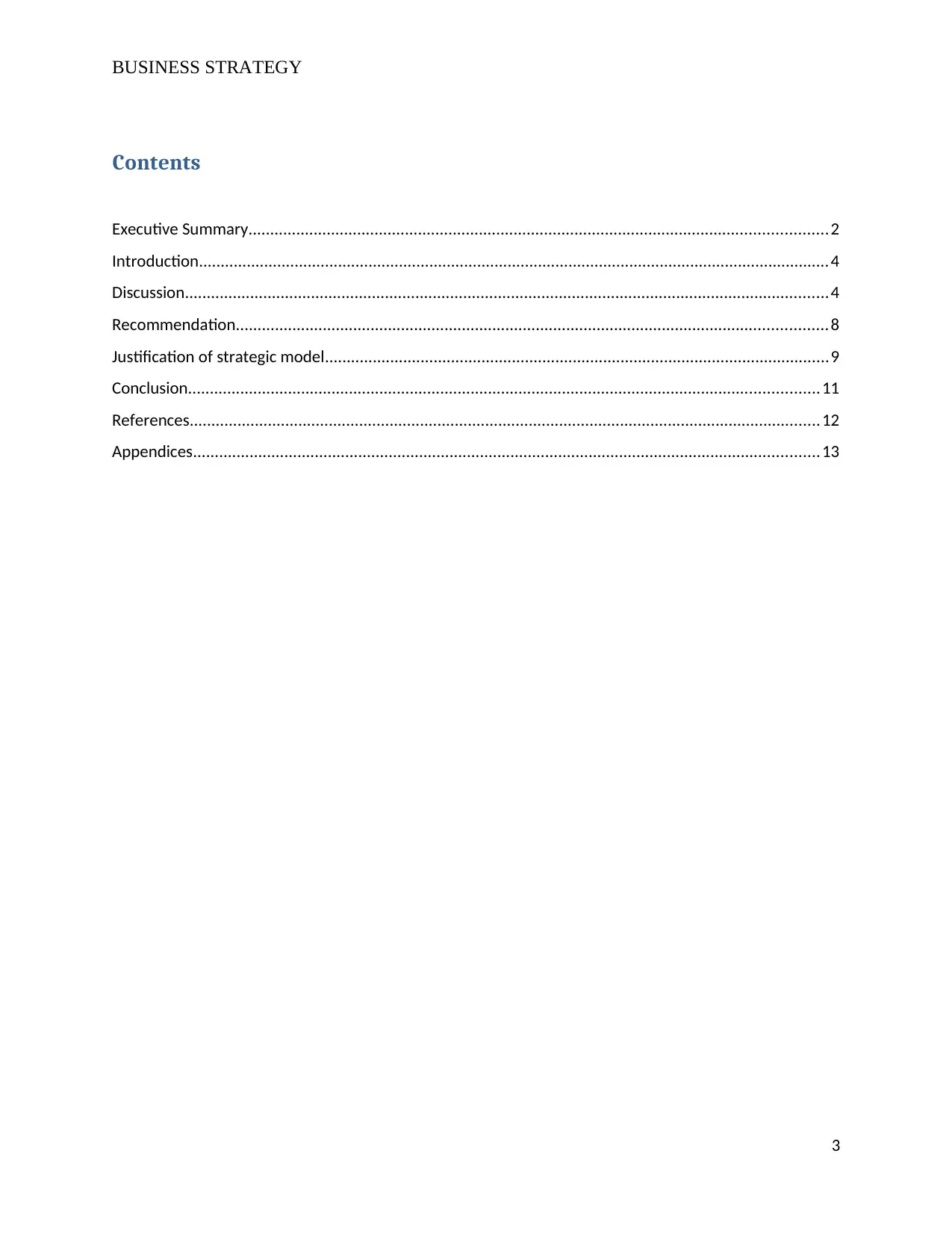
BUSINESS STRATEGY
Contents
Executive Summary.....................................................................................................................................2
Introduction.................................................................................................................................................4
Discussion....................................................................................................................................................4
Recommendation........................................................................................................................................8
Justification of strategic model....................................................................................................................9
Conclusion.................................................................................................................................................11
References.................................................................................................................................................12
Appendices................................................................................................................................................13
3
Contents
Executive Summary.....................................................................................................................................2
Introduction.................................................................................................................................................4
Discussion....................................................................................................................................................4
Recommendation........................................................................................................................................8
Justification of strategic model....................................................................................................................9
Conclusion.................................................................................................................................................11
References.................................................................................................................................................12
Appendices................................................................................................................................................13
3
⊘ This is a preview!⊘
Do you want full access?
Subscribe today to unlock all pages.

Trusted by 1+ million students worldwide

BUSINESS STRATEGY
Introduction
In this report strategic issue encountered by Museum of Contemporary arts that is situated in
Australia has been identified and analysed with consideration of Porter’s generic strategy
framework for better evaluation of issues. Also some recommendations are made for
improvements which are also supported with strategic framework for understanding of their
appropriateness. Hence the study is aimed to provide a broader understanding of different aspects
of strategic concepts and practices.
Discussion
According to Zbuchea (2015) with growth in widespread interest and investments both at
regional and international level, there seems to exist less skepticism situation on the rise of
stimulated demand for museums specifically towards contemporary art forms and Museum of
contemporary arts that is located in Australia. This enhancement in attention has been driven
through different imperative initiatives and demand for heterogeneous arts that has generated and
sustained audience growth. So in order to continue this rise in interest and demand from
audiences and investors it is indeed very essential for everyone engaged within the Museum of
Contemporary Arts (MCA) that is located in Australia and which includes different forms of
stakeholders interest such as artists, curators and programmers, educators, marketers to develop
experiences that fulfill both the learning curiosity and recreational expectations of new
audiences. As per ownership model MCA is a nonprofit organization or a charitable foundation
with aim to exhibit, collect and conserve art forms not only from Australia but from all over the
world with a social cause to preserve and unfold immense cultural and historical relevance of
these art works. But before strategic initiatives for redesigning art for MCA are undertaken it is
significant that major strategic issues that had been encountered at MCA are adequately
identified and then analyzed, to design appropriate strategies that could match new needs.
Strategic issues faced
4
Introduction
In this report strategic issue encountered by Museum of Contemporary arts that is situated in
Australia has been identified and analysed with consideration of Porter’s generic strategy
framework for better evaluation of issues. Also some recommendations are made for
improvements which are also supported with strategic framework for understanding of their
appropriateness. Hence the study is aimed to provide a broader understanding of different aspects
of strategic concepts and practices.
Discussion
According to Zbuchea (2015) with growth in widespread interest and investments both at
regional and international level, there seems to exist less skepticism situation on the rise of
stimulated demand for museums specifically towards contemporary art forms and Museum of
contemporary arts that is located in Australia. This enhancement in attention has been driven
through different imperative initiatives and demand for heterogeneous arts that has generated and
sustained audience growth. So in order to continue this rise in interest and demand from
audiences and investors it is indeed very essential for everyone engaged within the Museum of
Contemporary Arts (MCA) that is located in Australia and which includes different forms of
stakeholders interest such as artists, curators and programmers, educators, marketers to develop
experiences that fulfill both the learning curiosity and recreational expectations of new
audiences. As per ownership model MCA is a nonprofit organization or a charitable foundation
with aim to exhibit, collect and conserve art forms not only from Australia but from all over the
world with a social cause to preserve and unfold immense cultural and historical relevance of
these art works. But before strategic initiatives for redesigning art for MCA are undertaken it is
significant that major strategic issues that had been encountered at MCA are adequately
identified and then analyzed, to design appropriate strategies that could match new needs.
Strategic issues faced
4
Paraphrase This Document
Need a fresh take? Get an instant paraphrase of this document with our AI Paraphraser
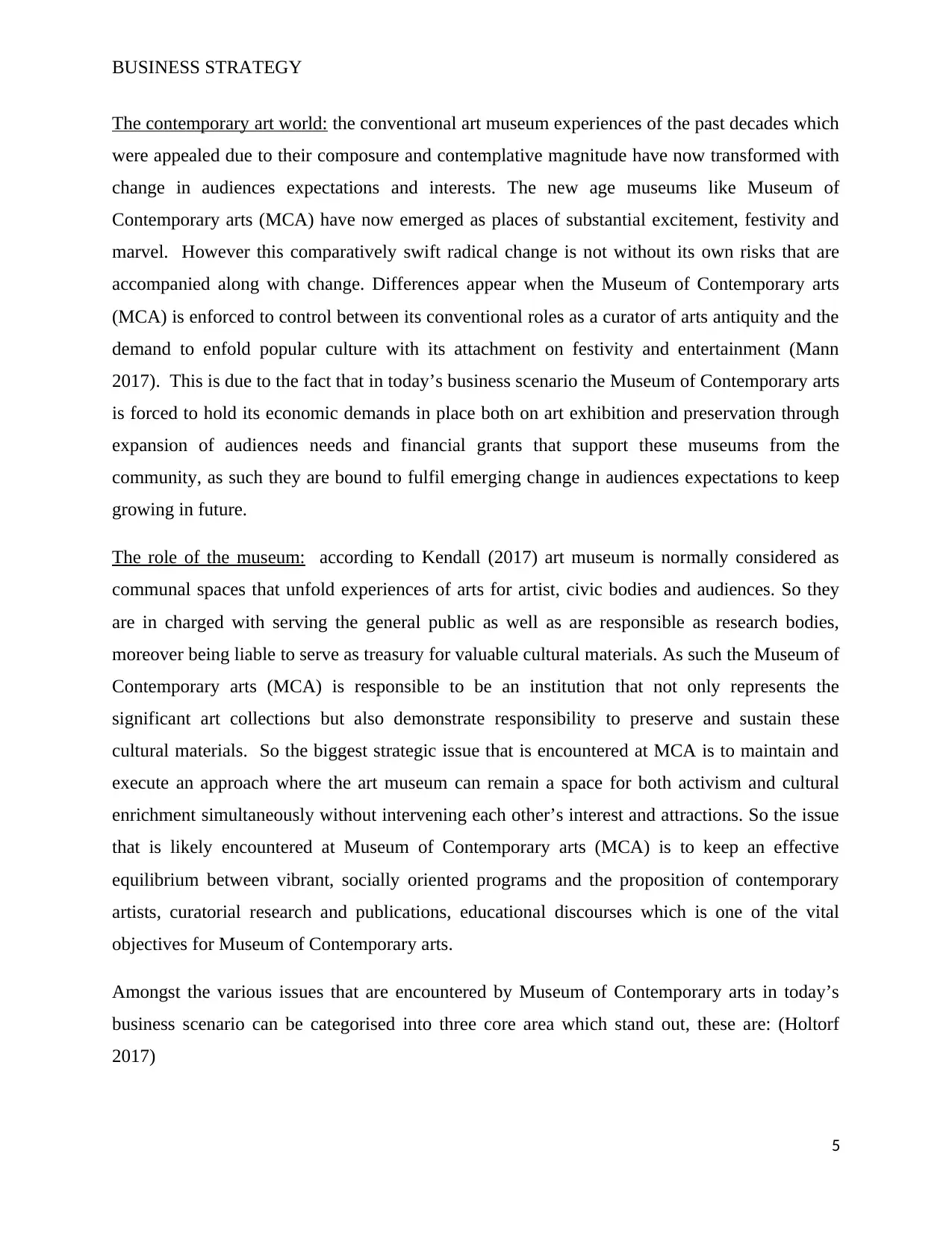
BUSINESS STRATEGY
The contemporary art world: the conventional art museum experiences of the past decades which
were appealed due to their composure and contemplative magnitude have now transformed with
change in audiences expectations and interests. The new age museums like Museum of
Contemporary arts (MCA) have now emerged as places of substantial excitement, festivity and
marvel. However this comparatively swift radical change is not without its own risks that are
accompanied along with change. Differences appear when the Museum of Contemporary arts
(MCA) is enforced to control between its conventional roles as a curator of arts antiquity and the
demand to enfold popular culture with its attachment on festivity and entertainment (Mann
2017). This is due to the fact that in today’s business scenario the Museum of Contemporary arts
is forced to hold its economic demands in place both on art exhibition and preservation through
expansion of audiences needs and financial grants that support these museums from the
community, as such they are bound to fulfil emerging change in audiences expectations to keep
growing in future.
The role of the museum: according to Kendall (2017) art museum is normally considered as
communal spaces that unfold experiences of arts for artist, civic bodies and audiences. So they
are in charged with serving the general public as well as are responsible as research bodies,
moreover being liable to serve as treasury for valuable cultural materials. As such the Museum of
Contemporary arts (MCA) is responsible to be an institution that not only represents the
significant art collections but also demonstrate responsibility to preserve and sustain these
cultural materials. So the biggest strategic issue that is encountered at MCA is to maintain and
execute an approach where the art museum can remain a space for both activism and cultural
enrichment simultaneously without intervening each other’s interest and attractions. So the issue
that is likely encountered at Museum of Contemporary arts (MCA) is to keep an effective
equilibrium between vibrant, socially oriented programs and the proposition of contemporary
artists, curatorial research and publications, educational discourses which is one of the vital
objectives for Museum of Contemporary arts.
Amongst the various issues that are encountered by Museum of Contemporary arts in today’s
business scenario can be categorised into three core area which stand out, these are: (Holtorf
2017)
5
The contemporary art world: the conventional art museum experiences of the past decades which
were appealed due to their composure and contemplative magnitude have now transformed with
change in audiences expectations and interests. The new age museums like Museum of
Contemporary arts (MCA) have now emerged as places of substantial excitement, festivity and
marvel. However this comparatively swift radical change is not without its own risks that are
accompanied along with change. Differences appear when the Museum of Contemporary arts
(MCA) is enforced to control between its conventional roles as a curator of arts antiquity and the
demand to enfold popular culture with its attachment on festivity and entertainment (Mann
2017). This is due to the fact that in today’s business scenario the Museum of Contemporary arts
is forced to hold its economic demands in place both on art exhibition and preservation through
expansion of audiences needs and financial grants that support these museums from the
community, as such they are bound to fulfil emerging change in audiences expectations to keep
growing in future.
The role of the museum: according to Kendall (2017) art museum is normally considered as
communal spaces that unfold experiences of arts for artist, civic bodies and audiences. So they
are in charged with serving the general public as well as are responsible as research bodies,
moreover being liable to serve as treasury for valuable cultural materials. As such the Museum of
Contemporary arts (MCA) is responsible to be an institution that not only represents the
significant art collections but also demonstrate responsibility to preserve and sustain these
cultural materials. So the biggest strategic issue that is encountered at MCA is to maintain and
execute an approach where the art museum can remain a space for both activism and cultural
enrichment simultaneously without intervening each other’s interest and attractions. So the issue
that is likely encountered at Museum of Contemporary arts (MCA) is to keep an effective
equilibrium between vibrant, socially oriented programs and the proposition of contemporary
artists, curatorial research and publications, educational discourses which is one of the vital
objectives for Museum of Contemporary arts.
Amongst the various issues that are encountered by Museum of Contemporary arts in today’s
business scenario can be categorised into three core area which stand out, these are: (Holtorf
2017)
5
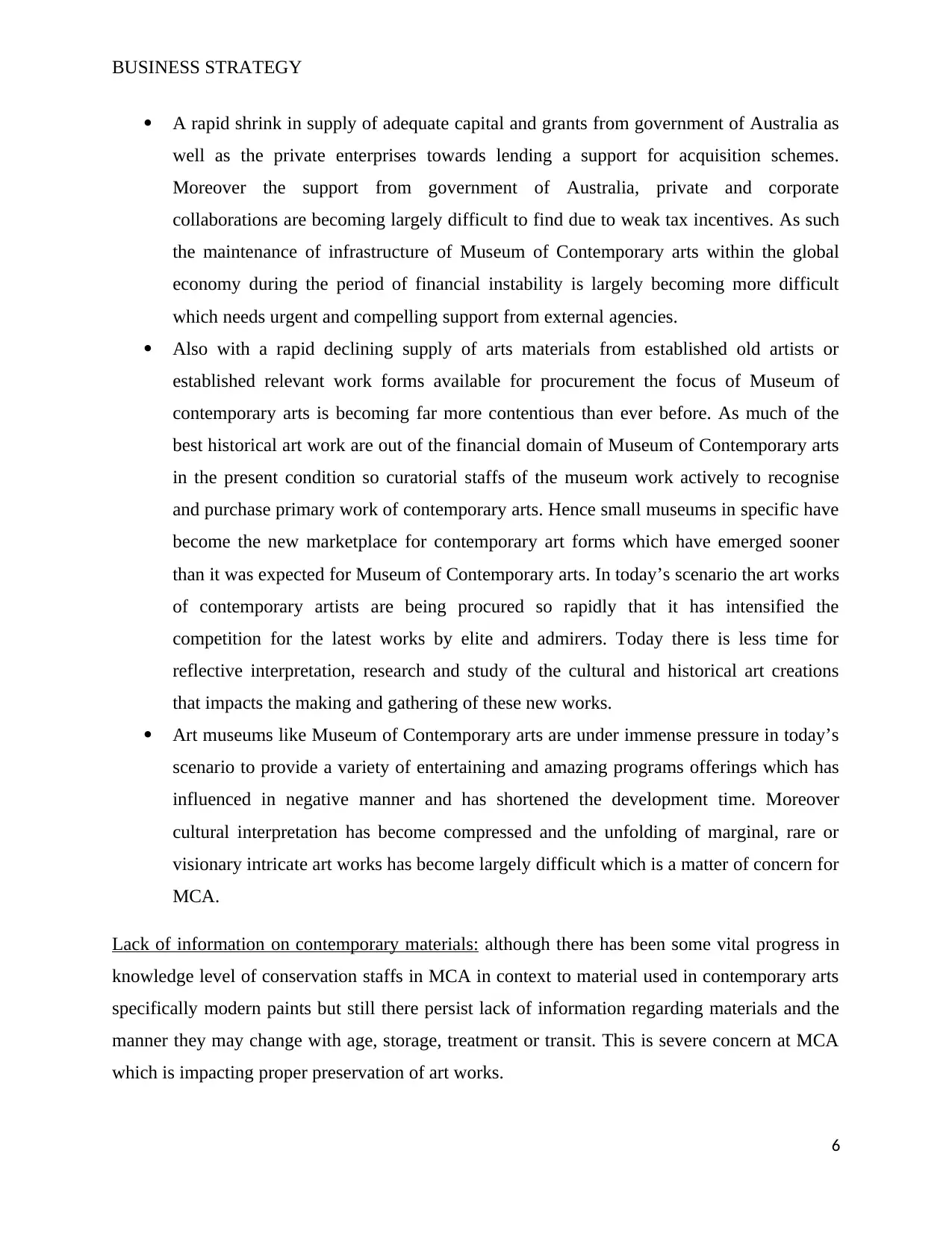
BUSINESS STRATEGY
A rapid shrink in supply of adequate capital and grants from government of Australia as
well as the private enterprises towards lending a support for acquisition schemes.
Moreover the support from government of Australia, private and corporate
collaborations are becoming largely difficult to find due to weak tax incentives. As such
the maintenance of infrastructure of Museum of Contemporary arts within the global
economy during the period of financial instability is largely becoming more difficult
which needs urgent and compelling support from external agencies.
Also with a rapid declining supply of arts materials from established old artists or
established relevant work forms available for procurement the focus of Museum of
contemporary arts is becoming far more contentious than ever before. As much of the
best historical art work are out of the financial domain of Museum of Contemporary arts
in the present condition so curatorial staffs of the museum work actively to recognise
and purchase primary work of contemporary arts. Hence small museums in specific have
become the new marketplace for contemporary art forms which have emerged sooner
than it was expected for Museum of Contemporary arts. In today’s scenario the art works
of contemporary artists are being procured so rapidly that it has intensified the
competition for the latest works by elite and admirers. Today there is less time for
reflective interpretation, research and study of the cultural and historical art creations
that impacts the making and gathering of these new works.
Art museums like Museum of Contemporary arts are under immense pressure in today’s
scenario to provide a variety of entertaining and amazing programs offerings which has
influenced in negative manner and has shortened the development time. Moreover
cultural interpretation has become compressed and the unfolding of marginal, rare or
visionary intricate art works has become largely difficult which is a matter of concern for
MCA.
Lack of information on contemporary materials: although there has been some vital progress in
knowledge level of conservation staffs in MCA in context to material used in contemporary arts
specifically modern paints but still there persist lack of information regarding materials and the
manner they may change with age, storage, treatment or transit. This is severe concern at MCA
which is impacting proper preservation of art works.
6
A rapid shrink in supply of adequate capital and grants from government of Australia as
well as the private enterprises towards lending a support for acquisition schemes.
Moreover the support from government of Australia, private and corporate
collaborations are becoming largely difficult to find due to weak tax incentives. As such
the maintenance of infrastructure of Museum of Contemporary arts within the global
economy during the period of financial instability is largely becoming more difficult
which needs urgent and compelling support from external agencies.
Also with a rapid declining supply of arts materials from established old artists or
established relevant work forms available for procurement the focus of Museum of
contemporary arts is becoming far more contentious than ever before. As much of the
best historical art work are out of the financial domain of Museum of Contemporary arts
in the present condition so curatorial staffs of the museum work actively to recognise
and purchase primary work of contemporary arts. Hence small museums in specific have
become the new marketplace for contemporary art forms which have emerged sooner
than it was expected for Museum of Contemporary arts. In today’s scenario the art works
of contemporary artists are being procured so rapidly that it has intensified the
competition for the latest works by elite and admirers. Today there is less time for
reflective interpretation, research and study of the cultural and historical art creations
that impacts the making and gathering of these new works.
Art museums like Museum of Contemporary arts are under immense pressure in today’s
scenario to provide a variety of entertaining and amazing programs offerings which has
influenced in negative manner and has shortened the development time. Moreover
cultural interpretation has become compressed and the unfolding of marginal, rare or
visionary intricate art works has become largely difficult which is a matter of concern for
MCA.
Lack of information on contemporary materials: although there has been some vital progress in
knowledge level of conservation staffs in MCA in context to material used in contemporary arts
specifically modern paints but still there persist lack of information regarding materials and the
manner they may change with age, storage, treatment or transit. This is severe concern at MCA
which is impacting proper preservation of art works.
6
⊘ This is a preview!⊘
Do you want full access?
Subscribe today to unlock all pages.

Trusted by 1+ million students worldwide
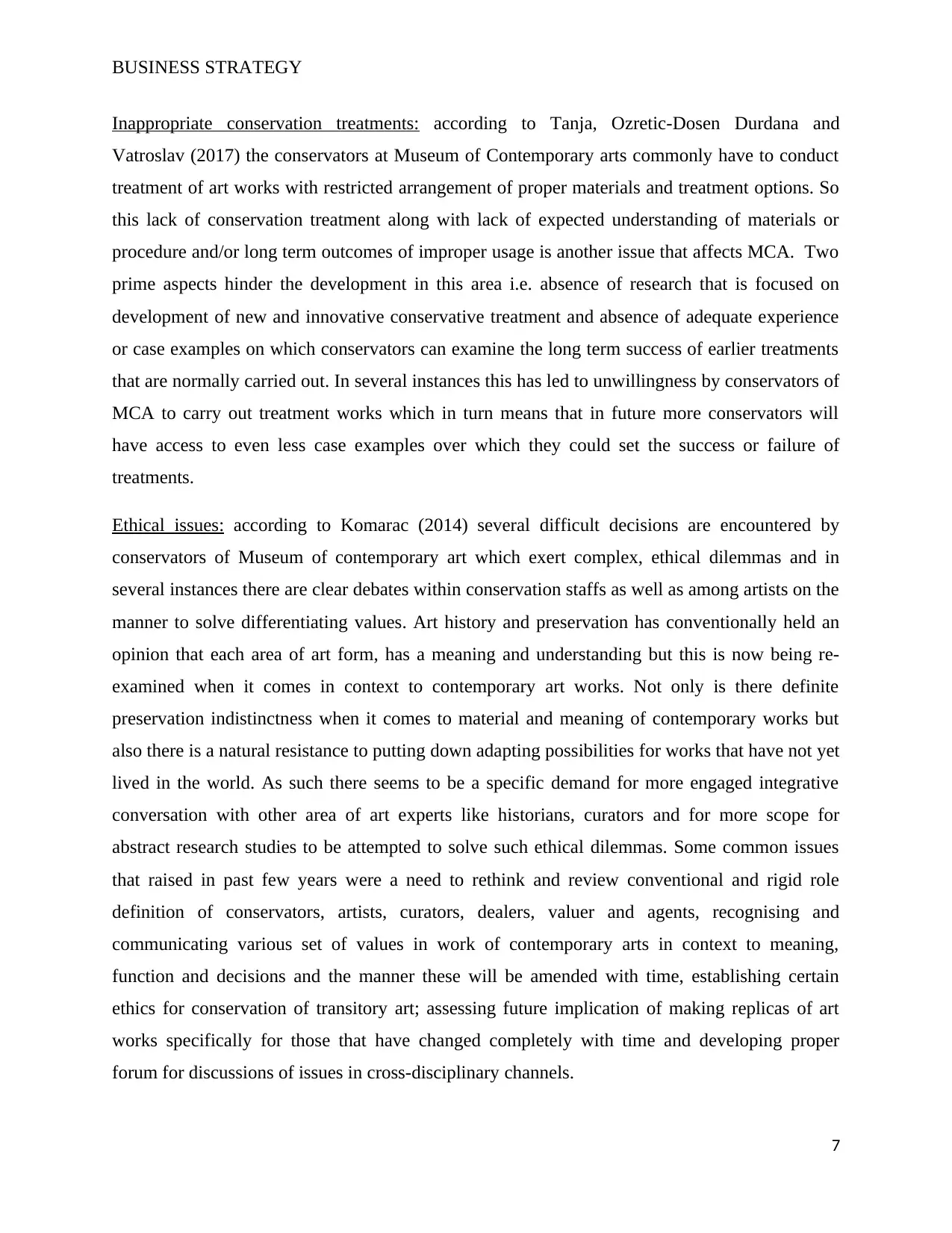
BUSINESS STRATEGY
Inappropriate conservation treatments: according to Tanja, Ozretic-Dosen Durdana and
Vatroslav (2017) the conservators at Museum of Contemporary arts commonly have to conduct
treatment of art works with restricted arrangement of proper materials and treatment options. So
this lack of conservation treatment along with lack of expected understanding of materials or
procedure and/or long term outcomes of improper usage is another issue that affects MCA. Two
prime aspects hinder the development in this area i.e. absence of research that is focused on
development of new and innovative conservative treatment and absence of adequate experience
or case examples on which conservators can examine the long term success of earlier treatments
that are normally carried out. In several instances this has led to unwillingness by conservators of
MCA to carry out treatment works which in turn means that in future more conservators will
have access to even less case examples over which they could set the success or failure of
treatments.
Ethical issues: according to Komarac (2014) several difficult decisions are encountered by
conservators of Museum of contemporary art which exert complex, ethical dilemmas and in
several instances there are clear debates within conservation staffs as well as among artists on the
manner to solve differentiating values. Art history and preservation has conventionally held an
opinion that each area of art form, has a meaning and understanding but this is now being re-
examined when it comes in context to contemporary art works. Not only is there definite
preservation indistinctness when it comes to material and meaning of contemporary works but
also there is a natural resistance to putting down adapting possibilities for works that have not yet
lived in the world. As such there seems to be a specific demand for more engaged integrative
conversation with other area of art experts like historians, curators and for more scope for
abstract research studies to be attempted to solve such ethical dilemmas. Some common issues
that raised in past few years were a need to rethink and review conventional and rigid role
definition of conservators, artists, curators, dealers, valuer and agents, recognising and
communicating various set of values in work of contemporary arts in context to meaning,
function and decisions and the manner these will be amended with time, establishing certain
ethics for conservation of transitory art; assessing future implication of making replicas of art
works specifically for those that have changed completely with time and developing proper
forum for discussions of issues in cross-disciplinary channels.
7
Inappropriate conservation treatments: according to Tanja, Ozretic-Dosen Durdana and
Vatroslav (2017) the conservators at Museum of Contemporary arts commonly have to conduct
treatment of art works with restricted arrangement of proper materials and treatment options. So
this lack of conservation treatment along with lack of expected understanding of materials or
procedure and/or long term outcomes of improper usage is another issue that affects MCA. Two
prime aspects hinder the development in this area i.e. absence of research that is focused on
development of new and innovative conservative treatment and absence of adequate experience
or case examples on which conservators can examine the long term success of earlier treatments
that are normally carried out. In several instances this has led to unwillingness by conservators of
MCA to carry out treatment works which in turn means that in future more conservators will
have access to even less case examples over which they could set the success or failure of
treatments.
Ethical issues: according to Komarac (2014) several difficult decisions are encountered by
conservators of Museum of contemporary art which exert complex, ethical dilemmas and in
several instances there are clear debates within conservation staffs as well as among artists on the
manner to solve differentiating values. Art history and preservation has conventionally held an
opinion that each area of art form, has a meaning and understanding but this is now being re-
examined when it comes in context to contemporary art works. Not only is there definite
preservation indistinctness when it comes to material and meaning of contemporary works but
also there is a natural resistance to putting down adapting possibilities for works that have not yet
lived in the world. As such there seems to be a specific demand for more engaged integrative
conversation with other area of art experts like historians, curators and for more scope for
abstract research studies to be attempted to solve such ethical dilemmas. Some common issues
that raised in past few years were a need to rethink and review conventional and rigid role
definition of conservators, artists, curators, dealers, valuer and agents, recognising and
communicating various set of values in work of contemporary arts in context to meaning,
function and decisions and the manner these will be amended with time, establishing certain
ethics for conservation of transitory art; assessing future implication of making replicas of art
works specifically for those that have changed completely with time and developing proper
forum for discussions of issues in cross-disciplinary channels.
7
Paraphrase This Document
Need a fresh take? Get an instant paraphrase of this document with our AI Paraphraser
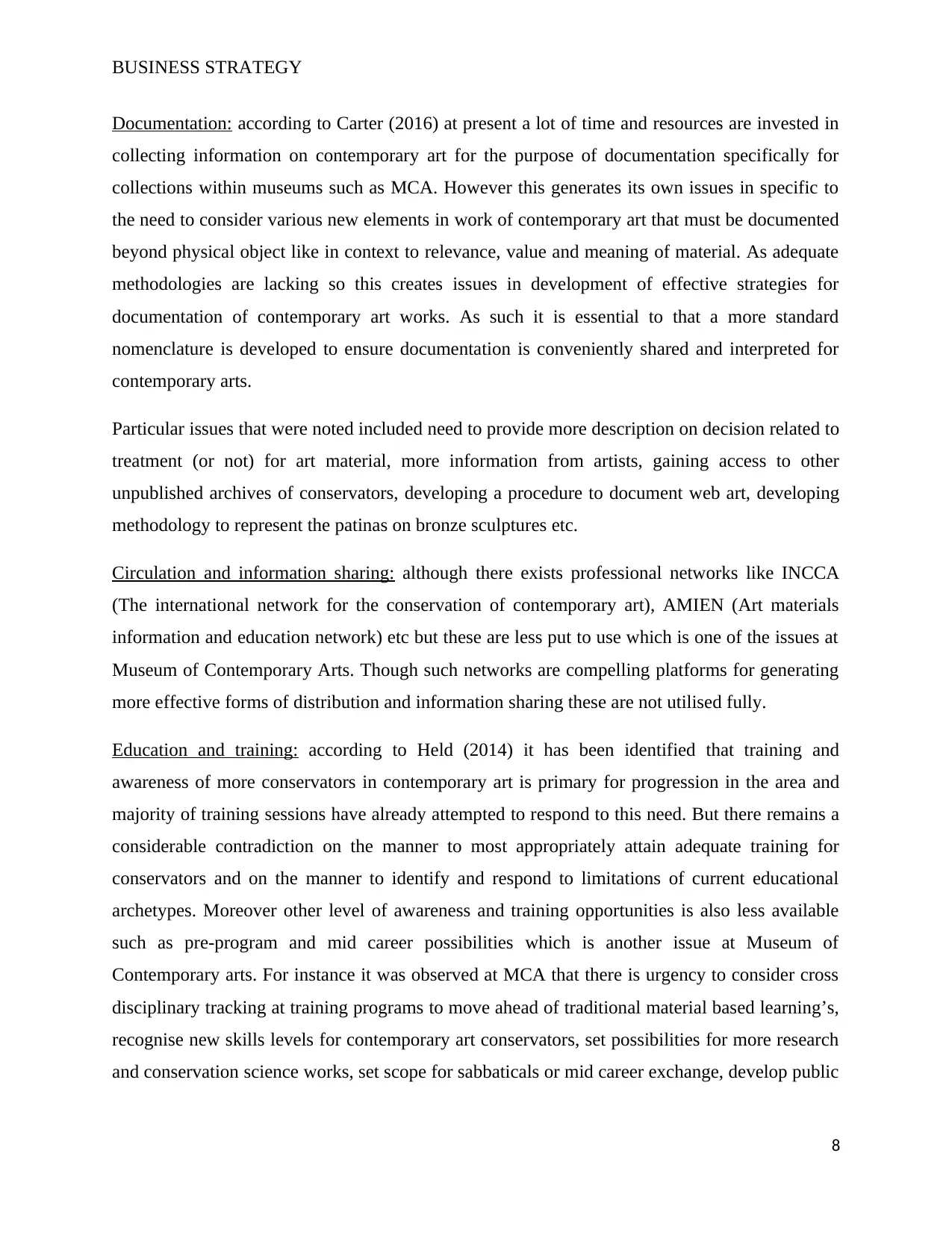
BUSINESS STRATEGY
Documentation: according to Carter (2016) at present a lot of time and resources are invested in
collecting information on contemporary art for the purpose of documentation specifically for
collections within museums such as MCA. However this generates its own issues in specific to
the need to consider various new elements in work of contemporary art that must be documented
beyond physical object like in context to relevance, value and meaning of material. As adequate
methodologies are lacking so this creates issues in development of effective strategies for
documentation of contemporary art works. As such it is essential to that a more standard
nomenclature is developed to ensure documentation is conveniently shared and interpreted for
contemporary arts.
Particular issues that were noted included need to provide more description on decision related to
treatment (or not) for art material, more information from artists, gaining access to other
unpublished archives of conservators, developing a procedure to document web art, developing
methodology to represent the patinas on bronze sculptures etc.
Circulation and information sharing: although there exists professional networks like INCCA
(The international network for the conservation of contemporary art), AMIEN (Art materials
information and education network) etc but these are less put to use which is one of the issues at
Museum of Contemporary Arts. Though such networks are compelling platforms for generating
more effective forms of distribution and information sharing these are not utilised fully.
Education and training: according to Held (2014) it has been identified that training and
awareness of more conservators in contemporary art is primary for progression in the area and
majority of training sessions have already attempted to respond to this need. But there remains a
considerable contradiction on the manner to most appropriately attain adequate training for
conservators and on the manner to identify and respond to limitations of current educational
archetypes. Moreover other level of awareness and training opportunities is also less available
such as pre-program and mid career possibilities which is another issue at Museum of
Contemporary arts. For instance it was observed at MCA that there is urgency to consider cross
disciplinary tracking at training programs to move ahead of traditional material based learning’s,
recognise new skills levels for contemporary art conservators, set possibilities for more research
and conservation science works, set scope for sabbaticals or mid career exchange, develop public
8
Documentation: according to Carter (2016) at present a lot of time and resources are invested in
collecting information on contemporary art for the purpose of documentation specifically for
collections within museums such as MCA. However this generates its own issues in specific to
the need to consider various new elements in work of contemporary art that must be documented
beyond physical object like in context to relevance, value and meaning of material. As adequate
methodologies are lacking so this creates issues in development of effective strategies for
documentation of contemporary art works. As such it is essential to that a more standard
nomenclature is developed to ensure documentation is conveniently shared and interpreted for
contemporary arts.
Particular issues that were noted included need to provide more description on decision related to
treatment (or not) for art material, more information from artists, gaining access to other
unpublished archives of conservators, developing a procedure to document web art, developing
methodology to represent the patinas on bronze sculptures etc.
Circulation and information sharing: although there exists professional networks like INCCA
(The international network for the conservation of contemporary art), AMIEN (Art materials
information and education network) etc but these are less put to use which is one of the issues at
Museum of Contemporary Arts. Though such networks are compelling platforms for generating
more effective forms of distribution and information sharing these are not utilised fully.
Education and training: according to Held (2014) it has been identified that training and
awareness of more conservators in contemporary art is primary for progression in the area and
majority of training sessions have already attempted to respond to this need. But there remains a
considerable contradiction on the manner to most appropriately attain adequate training for
conservators and on the manner to identify and respond to limitations of current educational
archetypes. Moreover other level of awareness and training opportunities is also less available
such as pre-program and mid career possibilities which is another issue at Museum of
Contemporary arts. For instance it was observed at MCA that there is urgency to consider cross
disciplinary tracking at training programs to move ahead of traditional material based learning’s,
recognise new skills levels for contemporary art conservators, set possibilities for more research
and conservation science works, set scope for sabbaticals or mid career exchange, develop public
8
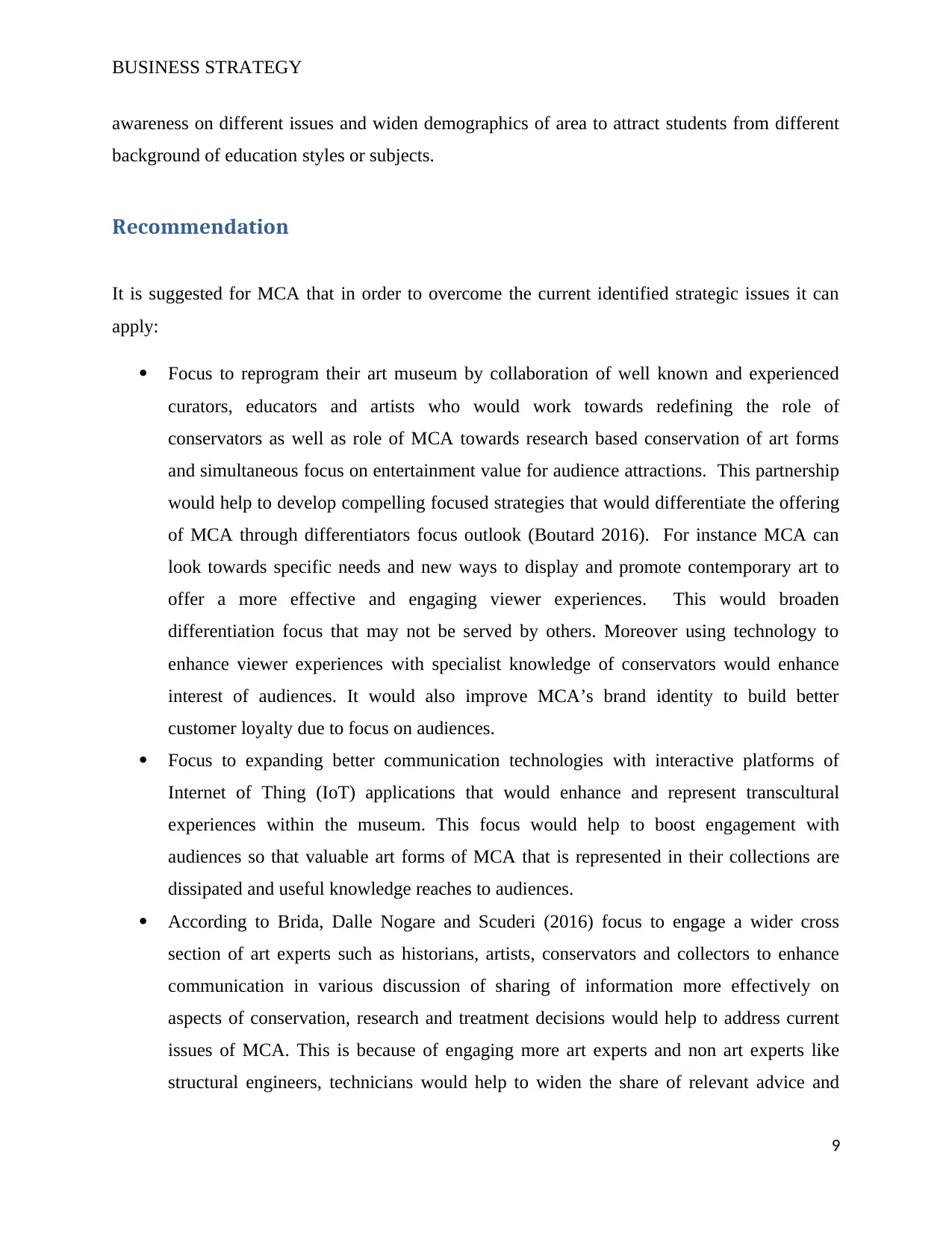
BUSINESS STRATEGY
awareness on different issues and widen demographics of area to attract students from different
background of education styles or subjects.
Recommendation
It is suggested for MCA that in order to overcome the current identified strategic issues it can
apply:
Focus to reprogram their art museum by collaboration of well known and experienced
curators, educators and artists who would work towards redefining the role of
conservators as well as role of MCA towards research based conservation of art forms
and simultaneous focus on entertainment value for audience attractions. This partnership
would help to develop compelling focused strategies that would differentiate the offering
of MCA through differentiators focus outlook (Boutard 2016). For instance MCA can
look towards specific needs and new ways to display and promote contemporary art to
offer a more effective and engaging viewer experiences. This would broaden
differentiation focus that may not be served by others. Moreover using technology to
enhance viewer experiences with specialist knowledge of conservators would enhance
interest of audiences. It would also improve MCA’s brand identity to build better
customer loyalty due to focus on audiences.
Focus to expanding better communication technologies with interactive platforms of
Internet of Thing (IoT) applications that would enhance and represent transcultural
experiences within the museum. This focus would help to boost engagement with
audiences so that valuable art forms of MCA that is represented in their collections are
dissipated and useful knowledge reaches to audiences.
According to Brida, Dalle Nogare and Scuderi (2016) focus to engage a wider cross
section of art experts such as historians, artists, conservators and collectors to enhance
communication in various discussion of sharing of information more effectively on
aspects of conservation, research and treatment decisions would help to address current
issues of MCA. This is because of engaging more art experts and non art experts like
structural engineers, technicians would help to widen the share of relevant advice and
9
awareness on different issues and widen demographics of area to attract students from different
background of education styles or subjects.
Recommendation
It is suggested for MCA that in order to overcome the current identified strategic issues it can
apply:
Focus to reprogram their art museum by collaboration of well known and experienced
curators, educators and artists who would work towards redefining the role of
conservators as well as role of MCA towards research based conservation of art forms
and simultaneous focus on entertainment value for audience attractions. This partnership
would help to develop compelling focused strategies that would differentiate the offering
of MCA through differentiators focus outlook (Boutard 2016). For instance MCA can
look towards specific needs and new ways to display and promote contemporary art to
offer a more effective and engaging viewer experiences. This would broaden
differentiation focus that may not be served by others. Moreover using technology to
enhance viewer experiences with specialist knowledge of conservators would enhance
interest of audiences. It would also improve MCA’s brand identity to build better
customer loyalty due to focus on audiences.
Focus to expanding better communication technologies with interactive platforms of
Internet of Thing (IoT) applications that would enhance and represent transcultural
experiences within the museum. This focus would help to boost engagement with
audiences so that valuable art forms of MCA that is represented in their collections are
dissipated and useful knowledge reaches to audiences.
According to Brida, Dalle Nogare and Scuderi (2016) focus to engage a wider cross
section of art experts such as historians, artists, conservators and collectors to enhance
communication in various discussion of sharing of information more effectively on
aspects of conservation, research and treatment decisions would help to address current
issues of MCA. This is because of engaging more art experts and non art experts like
structural engineers, technicians would help to widen the share of relevant advice and
9
⊘ This is a preview!⊘
Do you want full access?
Subscribe today to unlock all pages.

Trusted by 1+ million students worldwide

BUSINESS STRATEGY
experiences on various issues and forms of artwork, thus building effective awareness
within experts of cross section domain.
Justification of strategic model
Fig: Generic strategies
Source: toolshero (2018)
In order to solve the identified strategic issues the recommendations provided are based on
Generic Strategy Framework proposed by Porter. According to Johnson, Gerry et al. (2017) t’his
framework suggests distinctiveness of strategies based on cost, differentiation and focus which
are basic approaches that can lead business to attain competitive advantage. The cost leadership
approach includes attaining competitive advantage by becoming low cost provider in domain of
business activity while differentiation includes offering unique aspects that are largely valued by
customer to permit premium pricing. However focus strategy includes aiming to a specific
domain of business activity and subsequently personalising the offering to meet needs of
particular segment to the exclusion of others. It is further sub divided into cost and differentiation
focus where cost focus is cost focused strategies and differentiators is focused on differentiation.
The recommendations for improvement of strategic issues encountered by MCA are based on
differentiation focus strategy which is appropriate as it concentrates on widening specific needs
10
experiences on various issues and forms of artwork, thus building effective awareness
within experts of cross section domain.
Justification of strategic model
Fig: Generic strategies
Source: toolshero (2018)
In order to solve the identified strategic issues the recommendations provided are based on
Generic Strategy Framework proposed by Porter. According to Johnson, Gerry et al. (2017) t’his
framework suggests distinctiveness of strategies based on cost, differentiation and focus which
are basic approaches that can lead business to attain competitive advantage. The cost leadership
approach includes attaining competitive advantage by becoming low cost provider in domain of
business activity while differentiation includes offering unique aspects that are largely valued by
customer to permit premium pricing. However focus strategy includes aiming to a specific
domain of business activity and subsequently personalising the offering to meet needs of
particular segment to the exclusion of others. It is further sub divided into cost and differentiation
focus where cost focus is cost focused strategies and differentiators is focused on differentiation.
The recommendations for improvement of strategic issues encountered by MCA are based on
differentiation focus strategy which is appropriate as it concentrates on widening specific needs
10
Paraphrase This Document
Need a fresh take? Get an instant paraphrase of this document with our AI Paraphraser

BUSINESS STRATEGY
of audiences who visit museums through differentiator’s outlook that is specifically based on
reinforcing and reprogramming approaches in collaboration with various cross section experts
and research based archives. These would focus on improving technological integration to
differentiate and build better viewer’s experiences with effective interactive techniques that
would engage audiences. Also differentiation focus is suggested through specialist knowledge of
conservators and employees at MCA which will make information dissipation better for
audiences and they could connect with art forms that are exhibited. So suggestion and
evaluations are focused on specific segment and domain of activity which justifies the
framework.
Conclusion
Thus it is evident from this study that Museum of Contemporary arts has specific strategic issues
that are associated with role of contemporary arts against traditional art forms which are
perceived to be more theoretically preservers of antiquity of art compared to contemporary
forms. Also there is less clarity on role of museum as institution to conserve arts against
entertainment value that is more stressed nowadays to keep with customer demands. Also lack of
other issues such as awareness and training, ethical and documentation which have been
identified as concerns of MCA can be improved further with better knowledge provisions for
staffs and collaborative approaches for decisions to respond adequately to emerging needs. All
suggestions and approaches are evidenced with generic strategy framework for better
applicability of understanding.
11
of audiences who visit museums through differentiator’s outlook that is specifically based on
reinforcing and reprogramming approaches in collaboration with various cross section experts
and research based archives. These would focus on improving technological integration to
differentiate and build better viewer’s experiences with effective interactive techniques that
would engage audiences. Also differentiation focus is suggested through specialist knowledge of
conservators and employees at MCA which will make information dissipation better for
audiences and they could connect with art forms that are exhibited. So suggestion and
evaluations are focused on specific segment and domain of activity which justifies the
framework.
Conclusion
Thus it is evident from this study that Museum of Contemporary arts has specific strategic issues
that are associated with role of contemporary arts against traditional art forms which are
perceived to be more theoretically preservers of antiquity of art compared to contemporary
forms. Also there is less clarity on role of museum as institution to conserve arts against
entertainment value that is more stressed nowadays to keep with customer demands. Also lack of
other issues such as awareness and training, ethical and documentation which have been
identified as concerns of MCA can be improved further with better knowledge provisions for
staffs and collaborative approaches for decisions to respond adequately to emerging needs. All
suggestions and approaches are evidenced with generic strategy framework for better
applicability of understanding.
11
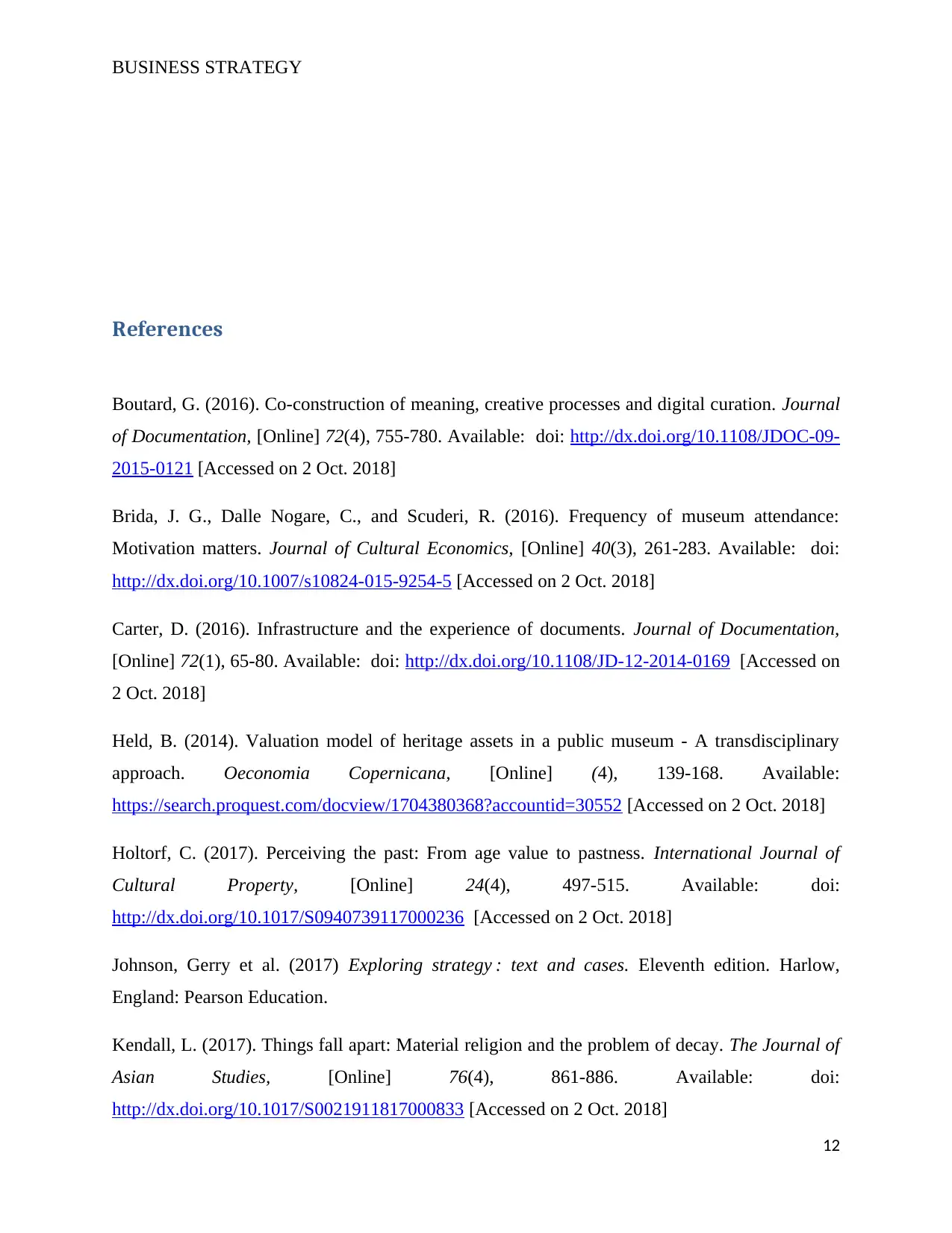
BUSINESS STRATEGY
References
Boutard, G. (2016). Co-construction of meaning, creative processes and digital curation. Journal
of Documentation, [Online] 72(4), 755-780. Available: doi: http://dx.doi.org/10.1108/JDOC-09-
2015-0121 [Accessed on 2 Oct. 2018]
Brida, J. G., Dalle Nogare, C., and Scuderi, R. (2016). Frequency of museum attendance:
Motivation matters. Journal of Cultural Economics, [Online] 40(3), 261-283. Available: doi:
http://dx.doi.org/10.1007/s10824-015-9254-5 [Accessed on 2 Oct. 2018]
Carter, D. (2016). Infrastructure and the experience of documents. Journal of Documentation,
[Online] 72(1), 65-80. Available: doi: http://dx.doi.org/10.1108/JD-12-2014-0169 [Accessed on
2 Oct. 2018]
Held, B. (2014). Valuation model of heritage assets in a public museum - A transdisciplinary
approach. Oeconomia Copernicana, [Online] (4), 139-168. Available:
https://search.proquest.com/docview/1704380368?accountid=30552 [Accessed on 2 Oct. 2018]
Holtorf, C. (2017). Perceiving the past: From age value to pastness. International Journal of
Cultural Property, [Online] 24(4), 497-515. Available: doi:
http://dx.doi.org/10.1017/S0940739117000236 [Accessed on 2 Oct. 2018]
Johnson, Gerry et al. (2017) Exploring strategy : text and cases. Eleventh edition. Harlow,
England: Pearson Education.
Kendall, L. (2017). Things fall apart: Material religion and the problem of decay. The Journal of
Asian Studies, [Online] 76(4), 861-886. Available: doi:
http://dx.doi.org/10.1017/S0021911817000833 [Accessed on 2 Oct. 2018]
12
References
Boutard, G. (2016). Co-construction of meaning, creative processes and digital curation. Journal
of Documentation, [Online] 72(4), 755-780. Available: doi: http://dx.doi.org/10.1108/JDOC-09-
2015-0121 [Accessed on 2 Oct. 2018]
Brida, J. G., Dalle Nogare, C., and Scuderi, R. (2016). Frequency of museum attendance:
Motivation matters. Journal of Cultural Economics, [Online] 40(3), 261-283. Available: doi:
http://dx.doi.org/10.1007/s10824-015-9254-5 [Accessed on 2 Oct. 2018]
Carter, D. (2016). Infrastructure and the experience of documents. Journal of Documentation,
[Online] 72(1), 65-80. Available: doi: http://dx.doi.org/10.1108/JD-12-2014-0169 [Accessed on
2 Oct. 2018]
Held, B. (2014). Valuation model of heritage assets in a public museum - A transdisciplinary
approach. Oeconomia Copernicana, [Online] (4), 139-168. Available:
https://search.proquest.com/docview/1704380368?accountid=30552 [Accessed on 2 Oct. 2018]
Holtorf, C. (2017). Perceiving the past: From age value to pastness. International Journal of
Cultural Property, [Online] 24(4), 497-515. Available: doi:
http://dx.doi.org/10.1017/S0940739117000236 [Accessed on 2 Oct. 2018]
Johnson, Gerry et al. (2017) Exploring strategy : text and cases. Eleventh edition. Harlow,
England: Pearson Education.
Kendall, L. (2017). Things fall apart: Material religion and the problem of decay. The Journal of
Asian Studies, [Online] 76(4), 861-886. Available: doi:
http://dx.doi.org/10.1017/S0021911817000833 [Accessed on 2 Oct. 2018]
12
⊘ This is a preview!⊘
Do you want full access?
Subscribe today to unlock all pages.

Trusted by 1+ million students worldwide
1 out of 15
Related Documents
Your All-in-One AI-Powered Toolkit for Academic Success.
+13062052269
info@desklib.com
Available 24*7 on WhatsApp / Email
![[object Object]](/_next/static/media/star-bottom.7253800d.svg)
Unlock your academic potential
Copyright © 2020–2026 A2Z Services. All Rights Reserved. Developed and managed by ZUCOL.





